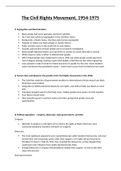The Civil Rights Movement, 1954-1975
1) Segregation and Discrimination.
Black people had worst-paid jobs and lived in ghettos.
Jim Crow laws enforced segregation in the Southern States.
Restaurants, schools, buses, churches and cinemas segregated.
Majority of whites saw black people as racially inferior.
Police and law courts in the South full of racist whites.
Assaults and murders of black people weren’t properly investigated.
Black people regularly beaten up to get them to confess to crimes they didn’t commit.
White lawyers made no effort to defend black people.
20% of black people were registered to vote in 1956, but white people would stop them
from voting by sacking, beating or give black people a hard literacy test when registering.
Laws passed to make it harder for black Americans to qualify for the vote. Some Southern
states introduced the grandfather clause – voters had to prove their forefathers had voted.
2) Factors that contributed to the growth of the Civil Rights Movements in the 1950s.
The Cold War made the US government sensitive to international criticism about how black
Americans were treated.
Integration in WW2 pushed the blacks for civil rights, and whites finally saw blacks as more
able.
Television brought events in the living room, making people more aware of racist injustice.
Poor blacks moved north.
New industries grew in southern towns and cities, giving black people more job
opportunities.
3) Political opposition – Congress, Dixiecrats, state governments, and WCC.
Congress:
Attempts to produce a civil rights act to enforce the rights of black Americans were
constantly blocked by Southern members of Congress.
Dixiecrats:
The most significant opponents were named Dixiecrats (after Southern Democrats), who had
formed their own breakaway party rather than support a civil rights bill put forward by
President Truman in 1948. By 1954, they re-joined the democrats, as they thought they
could have more influence from within the Democratic Party.
Enough Dixiecrats in Congress that presidents needed their support, so had to take their
views into account.
State governments:
, Southern governors, local mayors and other state officials favoured segregation.
They resisted desegregation in ways like shutting down all state schools, so they couldn’t be
integrated, or making school admission tests biased against black students, to prevent them
joining white schools.
They refused to end literacy tests, and continued to disrupt opportunities for black voters to
cast their vote.
There were no black judges and black juries were banned.
White Citizens’ Councils (WCC):
Set up from 1954 onwards to stop desegregation.
Protested, used violence, and used economic means, EG: fired black employees who were
involved in civil rights activities.
4) The NAACP
Formed 1909.
National Association for the Advancement of Coloured People.
NAACP focused on fighting for civil rights in the courts.
Helped wrongly convicted black people appeal.
Prosecuted white people who killed black people.
Brought cases to enforce voter registration.
5) Plessy vs Ferguson.
1896 – Supreme Court upheld the Jim Crow Laws, by saying blacks and white should be
separate, but have the equal facilities.
This enforced segregation, and facilities weren’t even equal.
NAACP lawyers overcame Plessy by providing evidence of unequal facilities, arguing equal
facilities weren’t the same as equal opportunities, and using psychological studies proving
racial inferiority.
6) CORE, RCNL and the Church.





